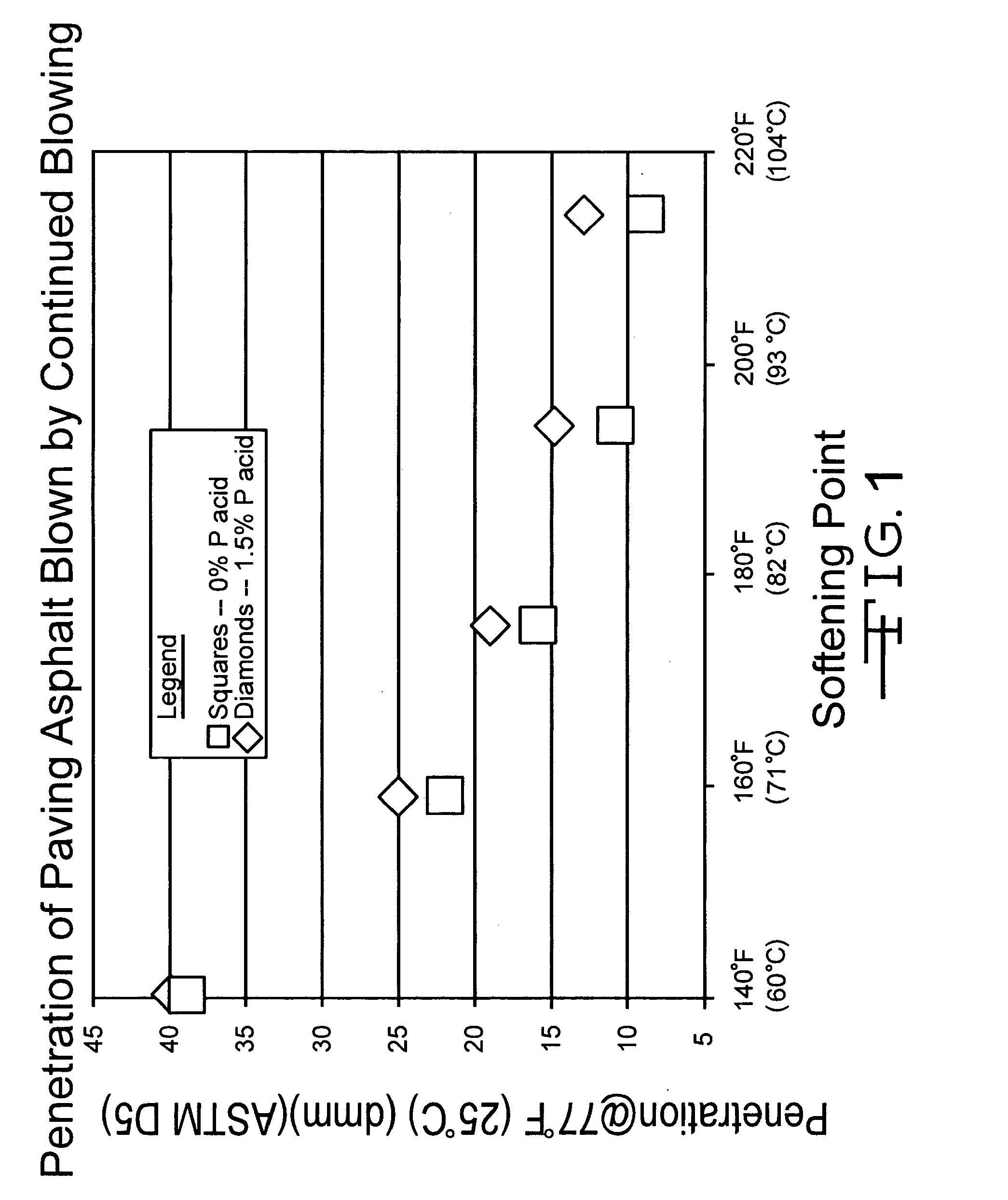Roofing coating asphalt composition
a technology of asphalt composition and roofing shingle, which is applied in the direction of roofing, textiles and papermaking, coatings, etc., can solve the problems of increasing short supply of special grades of asphalt that can be air-blown to make coating asphalt, increasing the cost of coating asphalt, and none of these techniques consistently meet the specifications of roofing shingle coating asphalt, etc., to achieve excellent stain index and storage stability
- Summary
- Abstract
- Description
- Claims
- Application Information
AI Technical Summary
Benefits of technology
Problems solved by technology
Method used
Image
Examples
example 1
[0058]Source A PG64-22 paving asphalt from the refining of Canadian crude oils is used as the starting asphalt. With the standard blowing process this material blows to a 211° F. (99° C.) softening point with a 6 dmm pen, much too hard a pen to make coating grade asphalt. The material can be made to a soft enough pen when blown with 2% phosphoric acid resulting in a softening point of 212° F. (100° C.) and a pen of 22 dmm but the melt viscosity is much too high at 704 cps. So with standard processes this material is not able to be made into coating. However with the method described in this invention the paving asphalt is partially blown with 1.5% phosphoric acid to a softening point of 172° F. (78° C.), 18 dmm pen and then a variety of waxes, shown below, can be added to the partially blown material to use this material to make coating asphalt.
Source A PG64-22 asphalt from Canadian crude blown to 172° F. (78° C.) SP with 1.5% active polyphosphoric acid catalyst then:
Wax AddedWax Ty...
example 2
[0059]Source B PG64-22 paving asphalt from the refining of Arab crude oils is used as the starting asphalt. With the standard blowing process this material blows to a 210° F. (99° C.) softening point with a 7 pen or much too hard for coating. Even with 1.5% phosphoric the pen at 214° F. (101° C.) SP is still too hard at 13 and the visc is much too high 640 cps. So with standard processes this material is not able to be made into coating. However with the method described in this invention the paving asphalt is partially blown with 1.5% phosphoric acid to a softening point of 172° F. (78° C.), 19 dmm pen and then a variety of waxes, shown below, can be added to the partially blown material to use this material to make coating asphalt.
Source B PG64-22 asphalt from Arab crude blown to 172° F. (78° C.) SP with 1.5% active polyphosphoric acid catalyst then:
Wax AddedWax TypeWax %SPpenviscSP Stability*Bareco PX105Fischer Tropsch2%202 F. (94 C.) 18 dmm202 cps0.5%OR Honeywell AC6Polyethylen...
example 3
[0060]Source C PG64-22 paving asphalt from the refining of Texas crude oils is used as the starting asphalt. With the standard blowing process this material blows to a 209° F. (98° C.) softening point with a pen of 9 dmm and a viscosity of 249 cps. The material can be made to a nearly soft enough pen (15) when blown with 1.5% phosphoric but the melt viscosity is too high at 430 cps. So with standard processes this material is not able to be made into coating. However with the method described in this invention the paving asphalt is partially blown with 1.5% phosphoric acid to a softening point of 165° F. (74° C.), 26 dmm pen and then a variety of waxes, shown below, can each be added to the partially blown material to use this material to make coating asphalt.
Source C PG64-22 asphalt from Texas crude blown to 165° F. (74° C.) SP with 1.5% active polyphosphoric acid catalyst then:
Wax AddedWax TypeWax %SPpenviscBareco PX105Fischer Tropsch3%191 F. (88 C.)20 dmm131 cpsOR Honeywell AC6Po...
PUM
| Property | Measurement | Unit |
|---|---|---|
| softening point | aaaaa | aaaaa |
| softening point | aaaaa | aaaaa |
| softening point | aaaaa | aaaaa |
Abstract
Description
Claims
Application Information
 Login to View More
Login to View More - R&D
- Intellectual Property
- Life Sciences
- Materials
- Tech Scout
- Unparalleled Data Quality
- Higher Quality Content
- 60% Fewer Hallucinations
Browse by: Latest US Patents, China's latest patents, Technical Efficacy Thesaurus, Application Domain, Technology Topic, Popular Technical Reports.
© 2025 PatSnap. All rights reserved.Legal|Privacy policy|Modern Slavery Act Transparency Statement|Sitemap|About US| Contact US: help@patsnap.com



